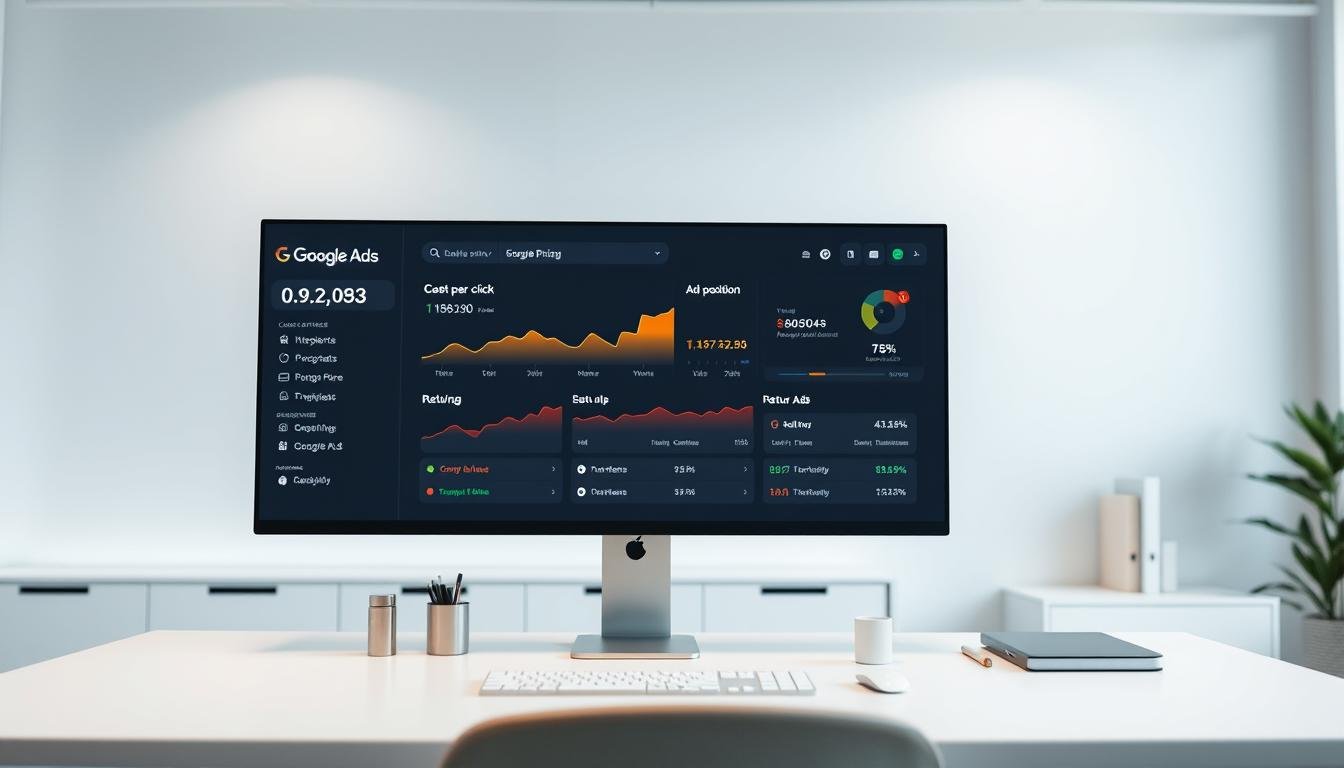The average cost per click in Google Ads is $5.26, and the average cost per lead is $70.11. These figures underscore the critical need for businesses to grasp Google Ads pricing. This knowledge is essential for maximizing ROI in online advertising.
For business owners, the intricacies of Google ad cost can seem overwhelming. Yet, with the right information, you can refine your campaigns for enhanced performance. This article will dissect the elements affecting Google ad pricing. It will also offer tips on budget management.
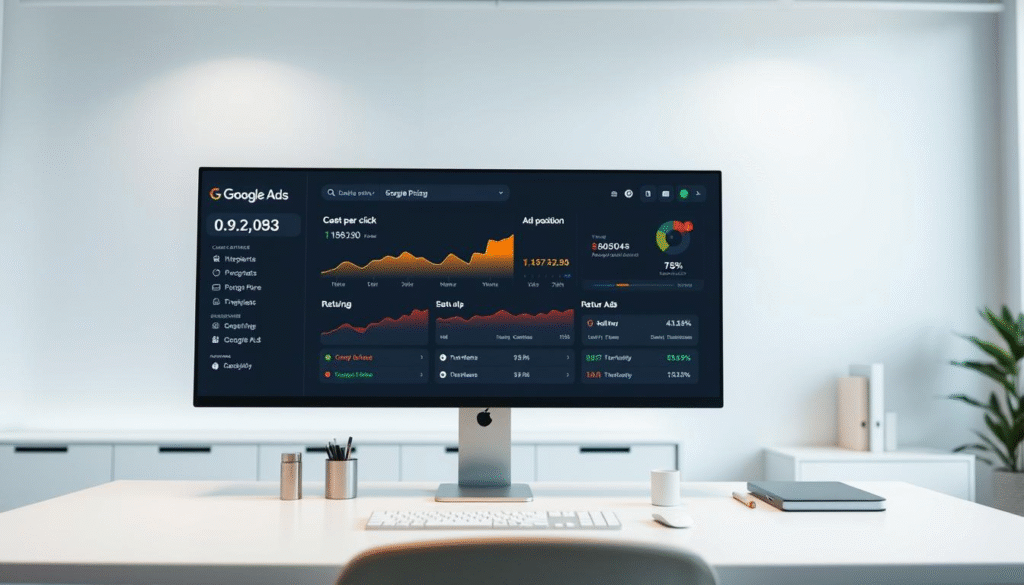
Key Takeaways
- Understand the average costs associated with Google Ads.
- Learn the factors that influence Google Ads pricing.
- Discover strategies for managing your Google Ads budget.
- Improve your ROI with optimized Google Ads campaigns.
- Explore best practices for Google Ads management.
Understanding the Google Ads Ecosystem
To excel with Google Ads, advertisers must comprehend its underlying mechanics. The platform operates within a complex ecosystem. This ecosystem is influenced by various factors that affect ad visibility and cost.
The Pay-Per-Click Model Explained
Google Ads operates on a pay-per-click (PPC) model. Advertisers pay each time a user clicks on their ad. The cost per click (CPC) can vary significantly. This is due to factors like keyword competition and ad quality. Grasping the PPC model is essential for managing google ad campaign cost effectively.
Different Google Ads Campaign Types and Their Cost Structures
Google Ads offers several campaign types, including Search, Display, and Video campaigns. Each campaign type has its own cost structure. For example, Search campaigns often have higher CPC due to intense keyword competition.
The Google Ads Auction Process
The Google Ads auction process determines ad placement and cost. Several factors influence ad position and CPC. These include bid amount, ad relevance, and landing page quality. An optimized ad can secure a higher position at a lower cost.
| Campaign Type | Average CPC | Cost Structure |
| Search | $1 – $10 | High competition, keyword-based |
| Display | $0.1 – $1 | Lower CPC, targeting based on user interests |
| Video | $0.1 – $5 | Cost per view or CPC, engaging visual content |
How Much Is It for a Google Ad? Breaking Down the Costs
The cost of Google Ads can vary significantly based on several factors, including industry and campaign type. Understanding these factors is essential for advertisers to manage their budgets effectively and maximize their return on investment.
Average Cost-Per-Click Across Industries
The average cost-per-click (CPC) for Google Ads varies widely across different industries. For instance, industries like legal services and insurance tend to have higher CPCs due to intense competition.
Here is a breakdown of average CPC across various industries:
| Industry | Average CPC |
| Legal Services | $2.50 – $5.00 |
| Insurance | $2.00 – $4.00 |
| E-commerce | $0.50 – $2.00 |
Cost Variations by Campaign Type
Different Google Ads campaign types have distinct cost structures. For example, Search campaigns tend to be more expensive than Display campaigns due to their intent-driven nature.
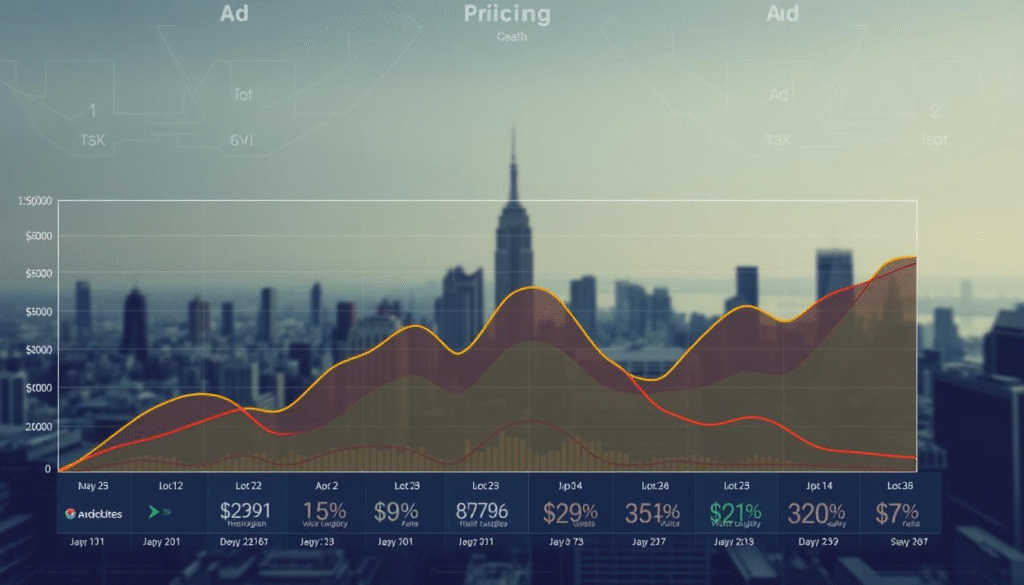
Geographic and Seasonal Cost Factors
Geographic location and seasonal trends also significantly impact Google Ads costs.
Regional Price Differences in the United States
Advertisers in different regions of the United States may face varying costs due to local competition and demand.
Holiday Season Impact on Ad Costs
During holiday seasons, ad costs can surge due to increased competition for consumer attention.
For example, during the holiday season, advertisers may see a significant increase in CPC, sometimes by as much as 20-30%, due to heightened competition.
Key Factors That Influence Your Google Ads Pricing
To optimize your Google Ads spend, understanding the various factors that affect pricing is essential. Google Ads operates in a complex ecosystem. Here, multiple elements interact to determine your ad costs.
Quality Score and Its Impact on Ad Costs
Quality Score is a critical factor in Google Ads pricing. It measures the relevance and quality of your ads, keywords, and landing pages. A higher Quality Score can lead to lower costs and better ad positions.
Ad Relevance and Expected CTR
Ad relevance and expected click-through rate (CTR) are also key. Google evaluates how relevant your ad is to the user’s search query. It also predicts the likelihood of users clicking on your ad. Higher ad relevance and expected CTR can improve your Quality Score, reducing costs.
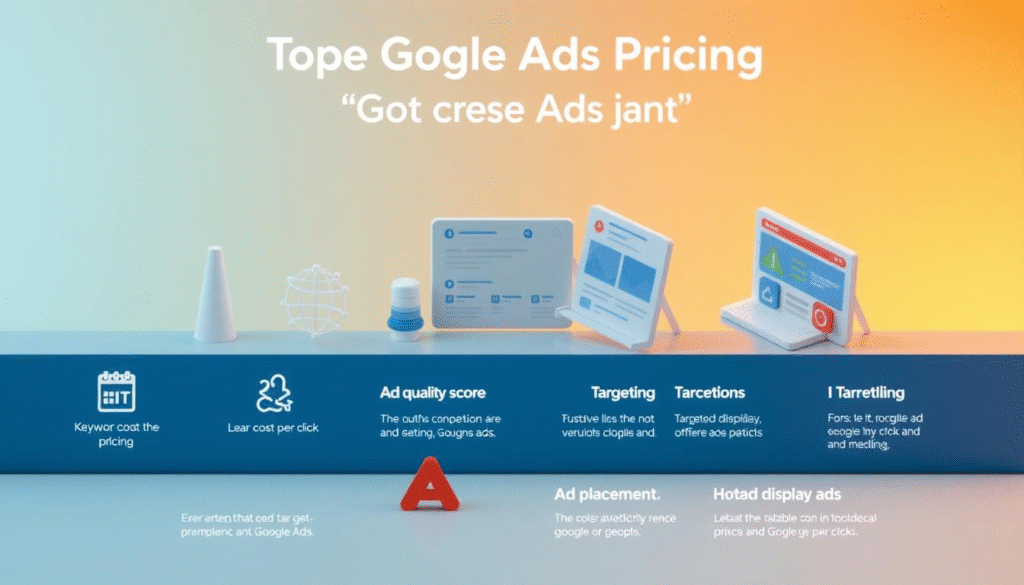
Industry Competition and Keyword Demand
Industry competition and keyword demand significantly influence Google Ads pricing. Highly competitive industries and popular keywords can drive up costs due to increased demand.
Landing Page Experience
The landing page experience is vital. Google assesses the relevance, transparency, and usability of your landing page. A well-optimized landing page can enhance your Quality Score and reduce ad costs.
Page Load Speed and Mobile Optimization
Page load speed and mobile optimization are critical for a good landing page experience. Ensuring your landing page loads quickly and is optimized for mobile devices can improve user experience. This, in turn, can enhance your Quality Score.
Content Relevance to Search Intent
The content on your landing page should align with the user’s search intent. Aligning your content with what users are searching for can enhance the overall quality of your ad campaign. This can also reduce costs.
| Factor | Impact on Google Ads Pricing | Optimization Strategy |
| Quality Score | Higher Quality Score = Lower Costs | Improve ad relevance, CTR, and landing page quality |
| Ad Relevance | Higher relevance = Better Quality Score | Ensure ad copy is relevant to keywords and search intent |
| Landing Page Experience | Better experience = Higher Quality Score | Optimize page load speed, mobile usability, and content relevance |
Google Ads Bidding Strategies Explained
To maximize your return on investment (ROI) with Google Ads, it’s essential to grasp the different bidding strategies available. Google Ads offers a range of bidding options that cater to various advertising goals. These goals include driving conversions and increasing brand visibility.
Manual CPC vs. Automated Bidding
Manual CPC (Cost-Per-Click) bidding allows advertisers to set their own bids for specific keywords or ad groups. This strategy provides control over ad spend but requires constant monitoring and adjustments. On the other hand, automated bidding uses machine learning algorithms to optimize bids based on the likelihood of conversion. Automated bidding strategies can save time and potentially improve campaign performance.
Target CPA and Target ROAS Strategies
Target CPA (Cost-Per-Acquisition) bidding is an automated strategy that aims to achieve a specific cost per conversion. This is ideal for advertisers with a clear understanding of their conversion costs. Target ROAS (Return on Ad Spend) bidding focuses on achieving a specific return on ad spend. It’s suitable for campaigns where revenue generation is a key objective.
Maximize Clicks and Maximize Conversions
The “Maximize Clicks” strategy is designed to drive traffic to your website by maximizing the number of clicks within your budget. “Maximize Conversions” is another automated strategy that aims to get as many conversions as possible within your budget. Both strategies are useful for advertisers looking to optimize their campaigns for specific performance metrics.
Enhanced CPC and When to Use It
Enhanced CPC bidding is a strategy that automatically adjusts your manual bids in real-time to try to maximize conversions. It’s a hybrid approach that combines the control of manual bidding with the optimization capabilities of automated bidding. This strategy is useful for advertisers who want to maintain some level of control while benefiting from automated bid adjustments.

By understanding and leveraging these Google Ads bidding strategies, advertisers can optimize their campaigns to achieve better performance and higher ROI. Whether you’re focusing on conversions, clicks, or revenue, there’s a bidding strategy that can help you meet your goals.
Setting Your Google Ads Budget: Step-by-Step Guide
Setting a Google Ads budget requires careful consideration of several factors. These factors impact your campaign’s performance. A well-planned budget helps manage costs and maximize ROI from your ads.
Determining Your Initial Budget Based on Goals
Start by setting your initial budget based on your goals. Whether you aim to increase website traffic, generate leads, or boost sales, your budget must align with these objectives. Consider the average CPC in your industry and the expected number of clicks.
Daily vs. Monthly Budget Allocation
Google Ads lets you set budgets daily or monthly. A daily budget is the average daily spend, while a monthly budget is the total monthly spend. Choosing between daily and monthly budgeting depends on your campaign’s specific needs and your preference for budget control.
| Budget Type | Description | Best For |
| Daily Budget | Average amount spent per day | Campaigns with consistent daily traffic |
| Monthly Budget | Total amount spent over a month | Campaigns with fluctuating daily traffic |
Budget Distribution Across Campaigns
When running multiple campaigns, effectively distributing your budget is critical. Allocate more to campaigns with high ROI. Regularly reviewing campaign performance helps in making informed decisions about budget allocation.
Budget Adjustment Strategies
Your Google Ads budget is not fixed; it should be adjusted based on performance. Sometimes, you’ll need to increase your budget, and other times, reallocate resources.
When to Increase Your Budget
If your campaigns are delivering a strong ROI and meeting your goals, it might be time to increase your budget. This can help scale your campaigns and potentially increase returns.
When to Reallocate Resources
Conversely, if some campaigns underperform, consider reallocating your budget to more successful ones. Continuous monitoring of campaign performance is key to making effective budget decisions.
Cost-Saving Techniques for Google Ads Campaigns
Advertisers can cut their Google ad costs by using the right campaign optimizations. Effective Google Ads management involves several strategies. These can help lower expenses while keeping or boosting campaign performance.
Improving Quality Score to Lower Costs
Improving your ads’ Quality Score is a key way to cut Google ad expenses. A higher Quality Score means lower cost-per-click (CPC) and better ad positions. This is achieved by making sure your ads match the keywords you target, improving your landing page, and boosting your ad’s expected click-through rate (CTR).
Implementing Negative Keywords
Using negative keywords is vital for managing Google ad costs. It stops irrelevant searches, cutting down on wasteful spending. Regularly checking your search terms report to add negative keywords can greatly enhance your campaign’s efficiency.
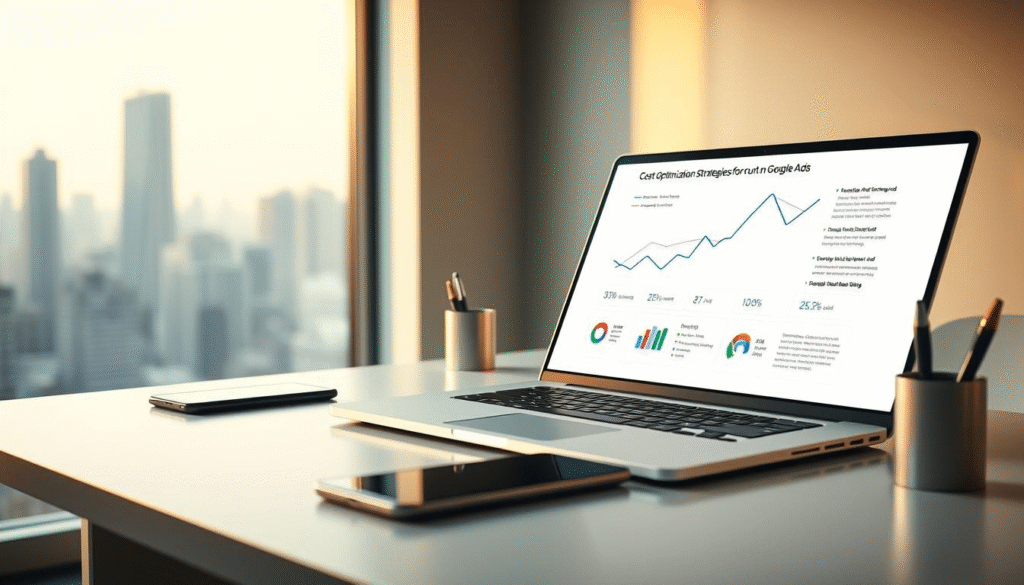
Ad Schedule Optimization for Better ROI
Optimizing your ad schedule can help you reach your audience at the best times. This can increase conversions and lower costs. By analyzing your campaign data to find peak performance times, you can adjust your ad scheduling for better ROI.
Geographic and Device Targeting to Control Expenses
Targeting your ads by geography and device can also manage Google ad expenses. Focusing on areas and devices that perform well helps allocate your budget better. Analyzing performance data to find top locations and devices, then adjusting your targeting, maximizes ROI.
Measuring and Analyzing Your Google Ads ROI
To truly understand the effectiveness of your Google Ads campaigns, it’s essential to measure and analyze your return on investment (ROI). This involves tracking key performance indicators, setting up proper conversion tracking, and calculating the return on ad spend.
Essential Performance Metrics to Track
To measure the success of your Google Ads campaigns, you need to track essential performance metrics. These include:
- Click-through rate (CTR)
- Conversion rate
- Cost per conversion
- Return on ad spend (ROAS)
By monitoring these metrics, you can identify areas for improvement and optimize your campaigns for better performance.
Setting Up Proper Conversion Tracking
Conversion tracking is vital to understanding the effectiveness of your Google Ads campaigns. It allows you to measure the number of conversions generated from your ads, such as form submissions, purchases, or phone calls.
To set up conversion tracking, you need to:
- Create a conversion action in your Google Ads account
- Add the conversion tracking code to your website
- Verify that the conversion tracking is working correctly
Calculating Return on Ad Spend
Return on ad spend (ROAS) is a critical metric that measures the revenue generated by your Google Ads campaigns compared to the cost of the ads. To calculate ROAS, you need to divide the revenue generated by the ad spend.
| Revenue | Ad Spend | ROAS |
| $1000 | $500 | 200% |
| $500 | $250 | 200% |
Using Google Analytics with Google Ads
Integrating Google Analytics with Google Ads provides a more detailed understanding of your campaign’s performance. It allows you to track website behavior, such as page views, bounce rates, and average session duration.
“By linking Google Analytics with Google Ads, you can gain a deeper understanding of your customers’ behavior and optimize your campaigns for better ROI.”
By following these steps and using the right tools, you can effectively measure and analyze your Google Ads ROI. This enables you to make informed decisions to optimize your campaigns and improve your return on investment.
Common Google Ads Pricing Mistakes to Avoid
Understanding Google Ads pricing is key to avoiding costly errors and maximizing your ad spend. Advertisers often make mistakes that can greatly affect their campaign’s success and return on investment.
Bidding Too High on Broad Match Keywords
Bidding too high on broad match keywords is a common mistake. It can result in irrelevant clicks and wasted budget. Consider using exact match keywords or phrase match keywords for better targeting.
Neglecting to Set Bid Adjustments
Not setting bid adjustments can lead to overpaying for ads. Adjust your bids based on device, location, and time of day to optimize your ad spend.
Ignoring Quality Score Optimization
A low Quality Score can increase your ad cost. Improve your ad relevance, landing page experience, and expected CTR to boost your Quality Score.
Setting and Forgetting Your Campaigns
Regularly monitoring and adjusting your Google Ads campaigns is essential. A set and forget approach can lead to missed opportunities and decreased ROI.
Avoiding these common mistakes can help optimize your Google Ads pricing and improve your campaign’s performance.
Conclusion: Maximizing Value from Your Google Ads Investment
In the complex world of Google Ads, optimizing your ad spend is vital for reaching your marketing targets. To get the most out of your Google Ads, focus on boosting your Quality Score and employing effective bidding strategies. This approach can reduce your costs and enhance your return on investment.
plays a critical role in campaign success. Regular budget reviews and adjustments, along with optimizing ad groups and keywords, lead to better google ad pricing. By adopting these strategies, your Google Ads campaigns will be more cost-effective and in line with your business goals.
Sources
The sources for this article come from trusted online platforms. For more details on Google Ads Pricing, check out these links:
- Google Ads Help Center
- Google Ads Blog
- WordStream
These platforms offer deep dives into Google Ads pricing structures, campaign planning, and how to improve your ads.
FAQ
How much does a Google Ad typically cost?
Google Ad costs vary widely. They depend on the industry, campaign type, and targeting. On average, the cost-per-click (CPC) can range from a few cents to several dollars.
What is the average cost-per-click for Google Ads?
The average CPC for Google Ads is around $1-$2. But, it can be much higher or lower. This depends on the industry and competition. For example, the legal industry tends to have higher CPCs, while the e-commerce industry may have lower CPCs.
How does Google Ads pricing work?
Google Ads operates on a pay-per-click (PPC) model. Advertisers pay each time a user clicks on their ad. The cost is determined through an auction process. This process considers factors like bid amount, ad relevance, and landing page experience.
What factors influence Google Ads costs?
Several factors influence Google Ads costs. These include Quality Score, ad relevance, industry competition, and landing page experience. Optimizing these factors can help reduce costs and improve ad performance.
How can I optimize my Google Ads budget?
To optimize your Google Ads budget, you can use several strategies. Improve Quality Score, implement negative keywords, and optimize ad schedules. Adjust your bidding strategy and allocate your budget effectively across campaigns.
What is the best bidding strategy for Google Ads?
The best bidding strategy for Google Ads depends on your campaign goals and performance. Options include manual CPC, automated bidding, target CPA, and target ROAS. Experiment with different strategies to find what works best for your business.
How do I measure the ROI of my Google Ads campaigns?
To measure the ROI of your Google Ads campaigns, track essential performance metrics. Set up conversion tracking and calculate return on ad spend (ROAS). Use Google Analytics in conjunction with Google Ads for deeper insights into your campaign performance.
What are some common mistakes to avoid in Google Ads pricing?
Common mistakes to avoid in Google Ads pricing include bidding too high on broad match keywords. Also, neglecting bid adjustments, ignoring Quality Score optimization, and setting and forgetting campaigns. Regularly reviewing and optimizing your campaigns can help you avoid these mistakes.
How can I reduce my Google Ads expenses?
To reduce your Google Ads expenses, implement cost-saving techniques. Improve Quality Score, use negative keywords, optimize ad schedules, and target specific geographic locations and devices.
